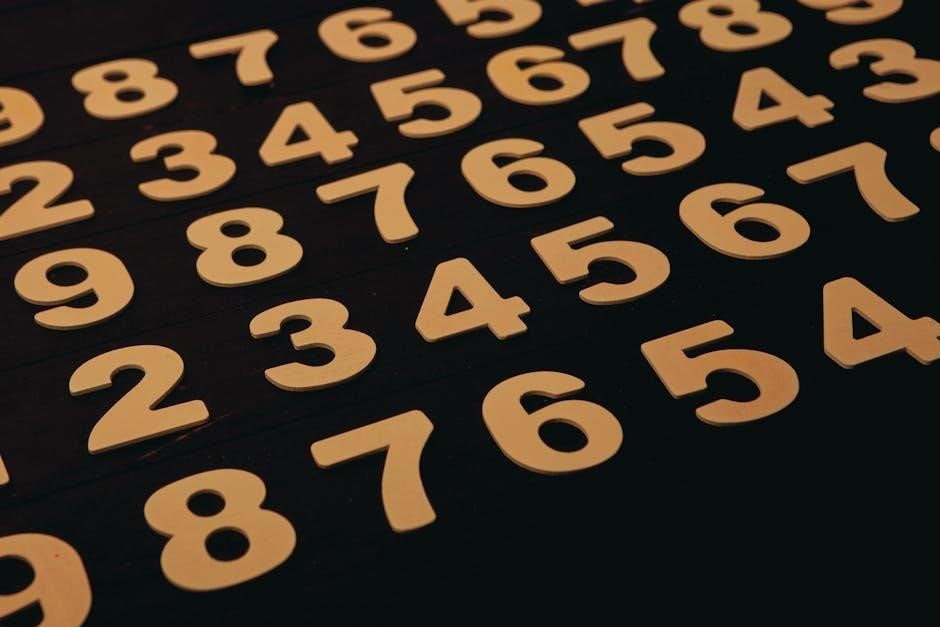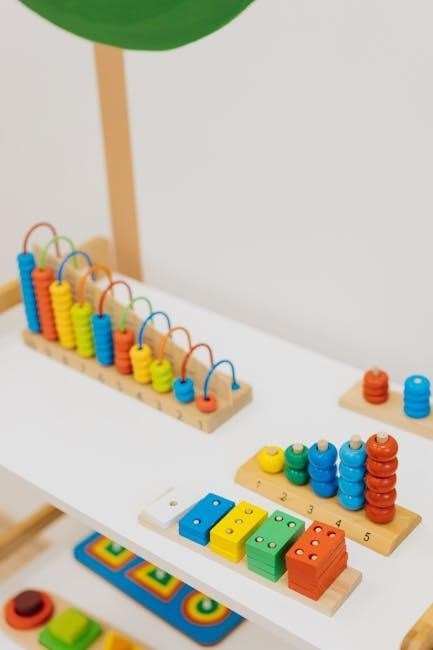Arithmetic sequence worksheets with answers PDF are essential tools for mastering arithmetic sequences, offering a structured approach to understanding patterns, common differences, and nth terms through practical exercises and real-life applications.
What Are Arithmetic Sequences?
An arithmetic sequence is a sequence of numbers where each term after the first is obtained by adding a constant difference to the preceding term. This constant is called the common difference. For example, in the sequence 2, 5, 8, 11, the common difference is 3. Arithmetic sequences are fundamental in identifying patterns and solving mathematical problems, making them a crucial concept in algebra and real-world applications.
Importance of Practicing Arithmetic Sequences
Practicing arithmetic sequences is crucial for developing problem-solving skills and understanding mathematical patterns. These sequences help in predicting outcomes, evaluating situations, and identifying relationships between terms. Regular practice with worksheets improves logical thinking and prepares students for advanced math concepts. Real-life applications, such as financial planning or scheduling, often rely on arithmetic sequences. Worksheets with answers provide a structured way to master these skills, ensuring accuracy and confidence in solving complex problems.
Key Terms and Concepts
Mastering arithmetic sequences involves understanding key concepts like common difference, nth term, explicit formula, recursive formula, and finite sequences. These terms form the foundation for solving problems and understanding sequence behavior, making them essential for effective practice with worksheets.
Common Difference
The common difference in an arithmetic sequence is the constant value added to each term to get the next term. It is calculated by subtracting any term from the term that follows it. For example, in the sequence 5, 9, 13, 17, the common difference is 4. A consistent common difference is essential for identifying and working with arithmetic sequences. Understanding this concept is fundamental for solving problems involving arithmetic sequences, as it directly impacts the nth term, explicit formula, and sum of terms.
Nth Term and Explicit Formula
The nth term of an arithmetic sequence is found using the explicit formula: aₙ = a₁ + (n-1)d, where aₙ is the nth term, a₁ is the first term, n is the term number, and d is the common difference. This formula allows direct calculation of any term without listing all previous terms. Worksheets provide ample practice in applying this formula, ensuring mastery of term calculation and reinforcing the relationship between sequence components. This skill is vital for advanced sequence applications and problem-solving.
Recursive Formula
The recursive formula for an arithmetic sequence defines each term based on the previous one: aₙ = aₙ₋₁ + d, where aₙ is the nth term, aₙ₋₁ is the preceding term, and d is the common difference. This approach builds each term step-by-step, emphasizing the sequence’s incremental nature. Worksheets often include exercises where students apply the recursive formula to find specific terms or generate sequences from given starting points and differences, reinforcing the foundational concept of progression in arithmetic sequences.
Finite Arithmetic Sequences
Finite arithmetic sequences have a defined endpoint, making them essential for real-world applications like budgeting or event planning. Worksheets often include problems where students identify the number of terms using the formula n = ((l ⎼ a) / d) + 1, where l is the last term, a is the first term, and d is the common difference. These exercises help learners grasp sequence limitations and practical uses, enhancing problem-solving skills in structured scenarios.
Finding the Common Difference
Finding the common difference involves calculating the constant gap between consecutive terms in an arithmetic sequence. Worksheets provide practical problems, such as determining d using given terms, enhancing understanding of sequence patterns and their real-world applications through structured exercises.
Examples of Finding the Common Difference
Finding the common difference is essential in arithmetic sequences. For example, in the sequence 3, 6, 9, 12, the common difference is 3. In another sequence like 15, 12, 9, 6, the common difference is -3. Worksheets often include problems like these, along with more complex examples, such as sequences with decimal differences, like 4.5, 6.8, 9.1, where the common difference is 2.3. These exercises help students master the concept through practical application.
Practical Problems for Practice
Practical problems in arithmetic sequence worksheets enhance learning by applying concepts to real-world scenarios. For instance, problems might involve calculating the number of rows in a theater with seats arranged in an arithmetic sequence. Other examples include determining the sum of the first 100 odd numbers or finding the number of terms in a sequence where the 10th term is 17 and the 14th term is 30. These exercises bridge theory with application, making learning engaging and relevant.
Determining the Nth Term
The nth term of an arithmetic sequence is found using the explicit formula: a_n = a_1 + (n-1)d. Worksheets provide exercises to apply this formula effectively.
Using the Explicit Formula
The explicit formula, a_n = a_1 + (n-1)d, allows direct calculation of any term in an arithmetic sequence. Worksheets provide structured exercises to apply this formula, ensuring mastery of term prediction. Students practice identifying the first term (a_1) and common difference (d) to find specific terms, enhancing problem-solving skills. These exercises are crucial for understanding sequence patterns and real-world applications, such as financial planning or scientific data analysis, where predicting future terms is essential.
Practice Exercises for the Nth Term
Arithmetic sequence worksheets with answers PDF include a variety of practice exercises to master finding the nth term. Students solve problems involving identifying the first term and common difference, then apply the explicit formula to determine specific terms. Exercises range from finding the 10th term to calculating terms in real-world scenarios, ensuring a deep understanding of sequence patterns. These worksheets often include answers for self-assessment, making them ideal for independent practice and reinforcing mathematical problem-solving skills.

Finite Arithmetic Sequences
Finite arithmetic sequences involve a limited number of terms, allowing students to practice identifying the first term, common difference, and last term to determine the total count of terms.
Identifying the Number of Terms
Identifying the number of terms in a finite arithmetic sequence involves using the explicit formula; By knowing the first term, common difference, and last term, students can calculate the total number of terms using the formula:
n = [(l ⎼ a) / d] + 1, where n is the number of terms, l is the last term, a is the first term, and d is the common difference. Worksheets provide practical problems to apply this formula, ensuring mastery of the concept through hands-on practice.
Applying the Formula for Finite Sequences
Applying the formula for finite arithmetic sequences helps determine the number of terms or the last term. Given the first term a, common difference d, and last term l, the formula n = [(l — a) / d] + 1 calculates the number of terms. Worksheets provide exercises where students use this formula to solve problems, such as finding the number of rows in a theater with seats arranged in an arithmetic sequence. These exercises reinforce understanding and prepare students for more complex sequence problems.

Sum of Terms in an Arithmetic Sequence
The sum of terms in an arithmetic sequence is calculated using the formula S_n = n/2 * (a_1 + a_n), where n is the number of terms, a_1 is the first term, and a_n is the nth term. Worksheets provide exercises to practice this formula, ensuring mastery of sum calculations for both finite and infinite sequences, with answers included for self-assessment and improved understanding.
Formula for the Sum of Terms
Arithmetic sequence worksheets provide the formula for the sum of terms, S_n = n/2 * (a_1 + a_n) or S_n = n/2 * [2a_1 + (n-1)d], where n is the number of terms, a_1 is the first term, and d is the common difference. These formulas allow calculation of the total sum of any sequence. Worksheets offer practice exercises with answers, helping students master sum calculations. They also highlight real-life applications, such as financial planning or budgeting, making the concept practical and relevant.
Examples and Exercises
Arithmetic sequence worksheets with answers PDF include numerous examples and exercises to practice finding terms, common differences, and sums. For instance, exercises like finding the sum of the first 100 odd numbers or identifying the number of terms in a sequence are common. These worksheets provide step-by-step solutions, making it easier for students to understand and apply formulas. Practical problems, such as calculating theater seating arrangements or financial plans, are also included to demonstrate real-world applications. This hands-on approach ensures mastery of arithmetic sequences.

Real-Life Applications of Arithmetic Sequences
Arithmetic sequences apply to real-life scenarios like theater seating, financial planning, and stacking objects. Worksheets with answers PDF help students explore these practical examples, enhancing problem-solving skills and understanding of sequence patterns in everyday situations.
Examples in Daily Life
Arithmetic sequences are evident in daily activities like theater seating arrangements, where rows increase by a fixed number of seats. They also appear in financial planning, such as monthly savings or loan payments, and in stacking objects like chairs or books, where each layer follows a consistent pattern. These real-world applications help students connect abstract concepts to practical scenarios, making learning more engaging and relevant. Worksheets with answers PDF provide exercises that mirror these situations, enhancing understanding and problem-solving skills.
Practical Problems Based on Real-Life Scenarios
Worksheets include practical problems like calculating theater seating arrangements or monthly savings plans, where arithmetic sequences model real-world patterns. Exercises involve finding the number of terms, sums, or explicit formulas for scenarios such as stacking objects or financial planning. These problems help students apply mathematical concepts to tangible situations, making learning interactive and relevant. Answers are provided for self-assessment, ensuring clarity and understanding of sequence applications in everyday life.
Differentiated Instruction
Arithmetic sequence worksheets offer differentiated instruction with levels for beginners, intermediate, and advanced learners, ensuring tailored practice and progression.
Worksheets for Beginners
Worksheets for beginners introduce foundational concepts of arithmetic sequences, focusing on identifying common differences, writing explicit formulas, and solving basic problems. They include step-by-step instructions and answer keys to ensure understanding. These worksheets are designed to build confidence, starting with simple sequences and gradually introducing more complex patterns. Real-life examples and visual aids are often included to make learning engaging and practical. Free downloadable PDFs allow easy access for students and educators to practice anywhere, anytime.
Intermediate-Level Problems
Intermediate-level problems in arithmetic sequence worksheets challenge students to apply their knowledge to more complex scenarios. These exercises focus on finding the nth term, calculating the sum of terms, and solving for common differences in diverse contexts. Worksheets include practical problems such as determining the number of terms in a sequence, identifying missing terms, and applying sequences to real-world situations. Detailed answer keys provide feedback, while varied problem sets ensure comprehensive understanding and preparation for advanced topics.
Advanced Arithmetic Sequence Challenges
Advanced arithmetic sequence challenges involve complex, multi-step problems requiring deep conceptual understanding. These include finding the nth term for large values, calculating the sum of extensive series, and solving for common differences in non-linear sequences. Worksheets often incorporate real-world applications, such as population growth or financial calculations, to test problem-solving skills. Detailed answers and explanations are provided to help students refine their techniques and prepare for higher-level mathematics.

Arithmetic Sequence Worksheets with Answers
Types of Problems Included
Arithmetic sequence worksheets with answers PDF include a variety of problems, such as finding the common difference, determining the nth term, calculating the sum of terms, and identifying patterns. They also feature exercises on finite sequences, real-life applications, and practical scenarios. Problems range from basic to advanced levels, catering to beginners, intermediate, and advanced learners. Additionally, these worksheets often include recursive and explicit formulas, ensuring a comprehensive understanding of arithmetic sequences. Answers are provided for self-assessment and learning reinforcement.
Downloading Free PDF Worksheets
Free arithmetic sequence worksheets with answers are readily available in PDF format from various educational websites. Platforms like Cuemath and EffortlessMath offer downloadable resources, often including editable versions for flexibility. These worksheets cater to different skill levels, from basic to advanced, and cover a range of topics such as finding common differences, nth terms, and sums of sequences. Many include answers, making them ideal for self-study and classroom use. They are a cost-effective solution for both students and educators.